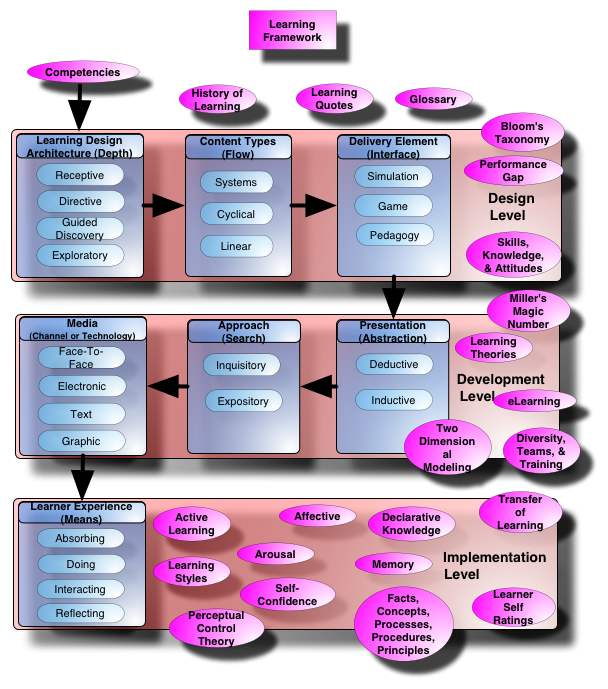Note: This site is moving to KnowledgeJump.com. Please reset your bookmark.
Learning and the Processing Framework
The levels of processing framework (Craik & Lockhart, 1972 and Cermak & Craik, 1979) postulates separate stages for sensory, working, and long-term memory. Information is processed at multiple levels simultaneously, depending on its characteristics. In addition, the deeper the processing, the more information that will be remembered. For example, information that references several contexts, such as a visual image and a story, will be processed at a deeper level. In addition, we remember events (stimuli) that are more meaningful to us, because it requires more processing than meaningless events.
Multimedia
During the early 1900's, the Visual Instructional Movement was born. Many of the leaders developed concrete/abstract continuums. In 1946, Edgar Dale's "Cone of Experience" was perhaps the most popular.
This was also the peak of the movement. During the early 1950's, the terminology started to change from "visual" or "audiovisual materials" to "instructional media." Note that the Visual Instructional Movement was primary concerned with the use of specific media. With the growth of psychological principles, this movement was slowly being replaced by "technology of instruction" (or educational technology), which is increasingly dependent on theory and empirical data.
However, it seems that media still keep rearing its head as the wannabe replacement for methods. There is a close relationship between the dual coding theory and the levels of processing framework. In 1971, Paivio developed the "dual-code" model, which proposes that there are at least two separate cognitive coding functions for visual and verbal information. However, after more than two decades of research, it is now quite controversial. In fact, there is a general agreement among researchers that the theory does not support the use of words and pictures. Although it seems to have face validity and it represents the beliefs of a lot of designers, there is a lot of compelling research evidence to be found in the literature that shows that multimedia is NOT multiplicative (greater than the sum of the benefits of individual media). For a list of the research, see: Richard Clark, (2001, pp. 89-101).
Thus, there is really no need to present "critical information" in more than one way. Now that does not mean you should not use more than one medium. Indeed, pictures can often convey greater meaning than words (or vice-versa). What it does mean is that each medium should convey a different context of the subject matter rather than merely repeating each other.
References
Cermak, L. & Craik, F. (1979). Levels of Processing in Human Memory. Hillsdale, NJ: Erlbaum.
Clark, Richard (2001). Learning from Media: Arguments, Analysis, and Evidence. Greenwich, Connecticut: Information Age Publishing.
Craik, F. & Lockhart, R. (1972). Levels of processing: A framework for memory research. Journal of Verbal Learning & Verbal Behavior. Vol 11, 671-684.

